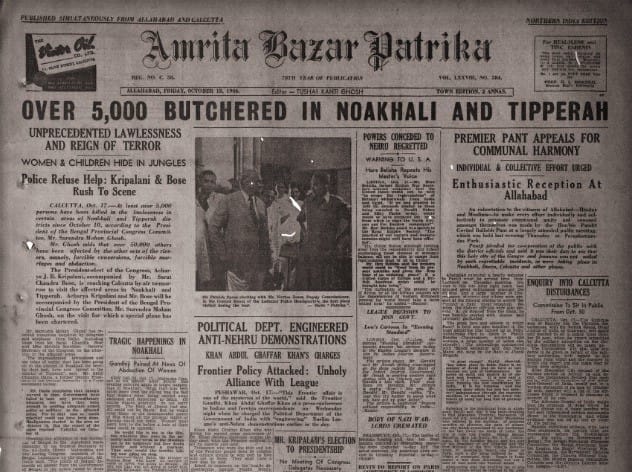
Noakhali Genocide (1946): Hidden and Unrevealed Facts🩸
The Noakhali genocide, one of the darkest yet underreported chapters in Indian history, unfolded in October–November 1946 in Noakhali and Tipperah districts of Bengal (now in Bangladesh). While mainstream history acknowledges it as a communal riot, deeper investigation reveals it was a planned campaign of ethnic cleansing against Hindus—marked by massacres, forced conversions, rapes, and destruction of Hindu identity. Much of this remains suppressed or sanitized in post-Partition discourse.
1. Premeditated and Systematic Ethnic Cleansing
The violence in Noakhali was not spontaneous but carefully orchestrated by Muslim League leaders, notably Ghulam Sarwar Husseini, a religious leader who incited mobs with calls for “direct action” against Hindus.
-
Militias like Miyar Fauz and Kasemer Fauz were formed to execute the violence.
-
Petrol and kerosene were ferried to remote island villages like Sandwip to burn Hindu homes—indicating logistical planning.
-
Hindu villages were looted and razed methodically; Muslim League volunteers directed mobs while local police remained passive or complicit.
📚 Source: Rakesh Batabyal, “Communalism in Bengal: From Famine to Noakhali, 1943–47”; Suranjan Das, “Communal Riots in Bengal (1905–1947)”
2. Deliberate Attack on Hindu Culture and Religion
The aim was not just to kill, but to erase Hindu identity:
-
Temples were desecrated, idols of Durga and Shiva were smashed, and scriptures burnt.
-
Hindu men were forced to perform namaz at gunpoint; women were stripped of shankha and sindur (symbols of marriage).
-
Forced conversions were rampant—over 22,550 in Tipperah alone, with many more unrecorded.
📚 Source: Edward Skinner Simpson Report (1946); Justice G.D. Khosla, “Stern Reckoning”
3. Sexual Violence as a Weapon
Sexual violence was systematic and weaponized to humiliate and subjugate:
-
Thousands of Hindu women were raped, abducted, and forcibly married—often within hours of abduction.
-
Survivors reported being gang-raped in mosques, paraded naked, and sold in markets.
-
Activist Leela Roy rescued over 1,300 abducted girls, but thousands remained missing.
📚 Source: Ashoka Gupta’s memoirs; Amrita Bazar Patrika (1946); British Intelligence Reports (IOR/L/PJ/8/655)
4. Forgotten Martyr: Rajendralal Roychowdhury
Roychowdhury, a Hindu leader and lawyer, defended his village with a rifle until his death. His severed head was presented to Sarwar as a trophy. Sucheta Kriplani hailed his sacrifice, comparing it to Shivaji and Guru Gobind Singh.
📚 Source: Ramesh Chandra Majumdar, “History of Bangla Desh”
5. Apathy and Cover-Up by British and Muslim League Authorities
Despite military intelligence warnings:
-
British Governor Frederick Burrows and PM Huseyn Suhrawardy delayed troop deployment for four critical days.
-
Suhrawardy offered absurd justifications like “blocked canals” and suggested airdropping leaflets instead of using force.
-
On 29 September 1946, the Bengal government passed an ordinance banning media coverage, and Simpson’s report was never officially released.
📚 Source: Francis Tuker, “While Memory Serves”; Ramesh Chandra Majumdar; The Statesman Archives
6. Gandhi’s Noakhali Mission – Hope and Helplessness
Mahatma Gandhi toured Noakhali from November 1946 to March 1947, promoting peace and non-violence:
-
His arrival brought temporary calm, but failed to ensure justice or rehabilitation.
-
Hindu survivors were disillusioned—Gandhi discouraged self-defense and focused instead on “Hindu atonement”.
-
Muslim villagers mocked Gandhi, refusing to join his prayer meetings, calling him a “Hindu agent”.
📚 Source: Pyarelal Nayyar, “Mahatma Gandhi: The Last Phase”; Nirmal Kumar Bose, “My Days with Gandhi”
7. Censorship, Propaganda, and Misinformation
-
Pro-Muslim League newspapers like The Star of India denied massacres, branding them as Hindu fabrications.
-
Truth-seekers were obstructed; official British records were classified or altered.
-
Anti-Hindu poetry and propaganda were spread weeks before the violence, psychologically preparing Muslim villagers for the assault.
📚 Source: Intelligence Bureau Files; “The Transfer of Power 1942–47”, Vol. IX
8. Massive Displacement and Seizure of Property
-
Over 50,000 Hindus fled to West Bengal, Assam, and Tripura.
-
Most never returned; their homes were looted, and lands seized under the Vested Property Act post-Partition.
📚 Source: Dinesh Chandra Sinha, “1946: The Great Calcutta Killings and Noakhali Genocide”
9. Suppressed Death Toll and Forgotten History
-
Official death estimates were 200–285, but independent sources suggest 10,000–20,000+ deaths.
-
Mass graves were found in Ramganj, Begumganj, Raipur, and other areas—many bodies were dumped in rivers.
-
Noakhali’s story was buried in history due to victims being low-caste, rural Hindus, and political discomfort post-Independence.
📚 Source: Ananda Bazar Patrika (1947); Dacca University’s “Noakhali Genocide Research Papers (2011)”

10. Chain Reaction: Retaliation in Bihar
The Noakhali massacre triggered anti-Muslim riots in Bihar (Oct–Nov 1946), with death tolls ranging from 5,000 to 30,000.
📚 Source: Ian Stephens, “Pakistan”
🕯️ Conclusion
The Noakhali genocide was not just a communal riot—it was a systematic, state-enabled pogrom. Despite its scale, India’s post-Partition memory selectively erased it, and generations grew up unaware of this carnage. Memorials are rare, justice was never delivered, and the victims’ stories remain whispers in the corridors of forgotten history.
Let this not remain hidden any longer.
Attaching Few Additional Source Links:-
https://x.com/KanchanGupta/status/1844380394189205879?lang=en
https://x.com/MrSinha_/status/1844406587819221062
https://egyankosh.ac.in/bitstream/123456789/33993/1/Unit-13.pdf



